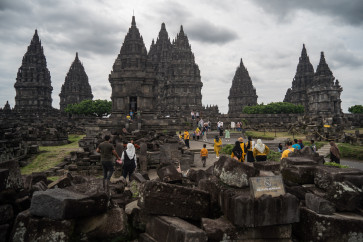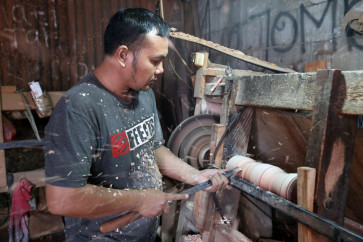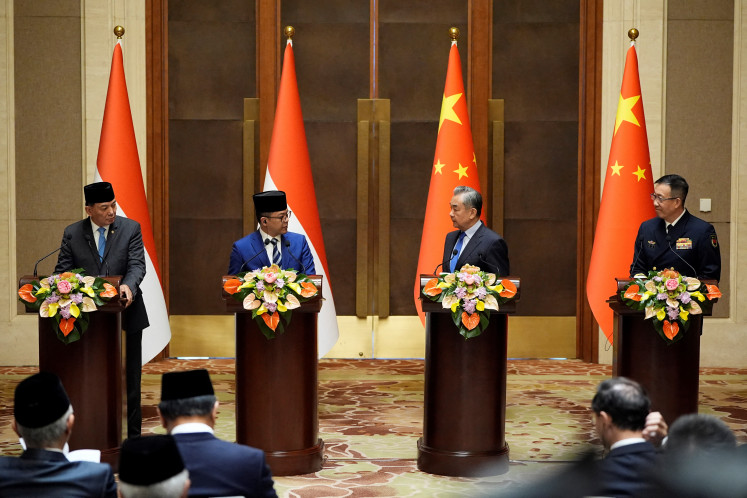A tribute to Bali's great prince
Dancers display ancient textiles from the Karangasem palace collection, following a performance of the Tenun dance during a memorial event honoring the late Anak Agung Made Djelantik
Change text size
Gift Premium Articles
to Anyone

Dancers display ancient textiles from the Karangasem palace collection, following a performance of the Tenun dance during a memorial event honoring the late Anak Agung Made Djelantik. (JP/Wasti Atmodjo)
A tribute to the late Anak Agung Made Djelantik last Saturday saw the beautiful Taman Soekasada Ujung water palace adorned with aesthetic pieces from the island's best artists and poets.
All were committed to showing their homage to the prince, who dedicated his life to selfless endeavors in the fields of public health, education and art.
Anak Agung Made Djelantik passed away at the ripe age of 88 on Sept. 4, 2007, at the Denpasar's Sanglah Central Hospital -- the institution he helped establish in the 1960s -- from liver disease.
"He was a generous teacher, a compassionate physician and an ardent cultural lover. He is the finest example of a Balinese man who has succeeded in embracing modernity without abandoning traditional roots," one of Djelantik's prot*g*s, Made Bandem said upon hearing of his passing.
Born on July 21, 1919, Djelantik was the son of AA Anglurah Ketut Karangasem, the last king of Karangasem. In 1946, he received his degree in medicine from Amsterdam University.
In the following 12 years, he was assigned various remote posts in Indonesia, including on Buru Island. In 1965, he co-founded the Indonesian Dance Academy in Denpasar.
From 1968 until 1980, Djelantik served as the World Health Organization's malaria expert in several regions, including Somalia, Iraq and Afghanistan.
Upon his return to Bali, Djelantik served at various cultural foundations and institutions. His books, Balinese Paintings (1996) and Estetika (1998) are still considered the most lucid depictions of traditional Balinese performing and fine arts.
Djelantik is survived by his five children and 13 grandchildren. His Dutch-born wife, Astri Henriete Zwart, passed away in 1997.
A memorial for Anak Agung Made Djelantik was organized by his children and close friends.
"It is a way to celebrate the exemplary life of this great man, whom I and my brother and sisters had the privilege to call our father," Djelantik's daughter, Bulantrisna, said.
The highlights of the memorial included traditional dance performances by Djelantik's relatives. His nieces and granddaughters performed the dynamic Tenun dance, which narrated the activities of traditional garment weavers.
At the end of the performance, the dancers took turns at showing ancient textiles from the Karangasem palace collection.
Djelantik's sole son, Widoere Djelantik, mesmerized spectators with his powerful performance of the Balinese warrior dance, Baris. Accompanied by his uncle, IB Ratu Sanca, Widoere virtually ruled the stage, which was set against the tranquil spaciousness of Bali's southern sky and sea.
Earlier, Italian honorary consul-cum-Topeng dancer Giuseppe "Pino" Confessa engaged Bali's leading shadow puppeteer I Made Sidia in a comic performance of Bondres.
Despite the humorous nature of Bondres, Pino didn't miss the chance to pay his respects to Djelantik, whom he called "a courageous individual, an intelligent person, an inspiring teacher and a great artist".
One of Djelantik's nieces, AAA Kesuma Arini, presented a dance specifically choreographed for Djelantik. The title of the dance was "Kupu-kupu Kuning" (the yellow butterflies), an obvious reference to a host of yellow butterflies that in 1692 assisted the royal army of Karangasem in its expedition to conquer the neighboring island of Lombok.
All the performances were eclipsed by the Legong Asmarandana dance, which was performed by Djelantik's daughters. They were led by Bulantrisna, an accomplished dentist and an expert dancer.
The dance took the hundreds-strong crowd's breath away, who flocked the water palace.
"What a family of great artists," one guest commented.
Earlier in the afternoon, the memorial event was kicked off with a book launch. The book, Menepis Segala Rintangan (Against All Odds), was a visual biography of Anak Agung Made Djelantik written by Idanna Pucci.
Djelantik's family also held an exhibition of Anak Agung Made Djelantik's photographs and paintings.
At the end of the memorial, Djelantik's family presented each and every guest with the seeds of various plants -- an obvious symbol that the most fitting tribute for a great man was a commitment to continue his work and preserve his legacies.









